Leo Minor Constellation aka The Lesser Lion
Leo Minor constellation is a small constellation that we can see in the northern sky. It is also referred to as “the Lesser Lion.”
Bright stars are rare in this constellation. In fact, only its brightest star is brighter than magnitude four. It is a relatively new constellation designated in 1687. Johannes Hevelius created and described it in his atlas Firmamentum Sobiescianum. It remains one of the 88 modern constellations of today. The International Astronomical Union (IAU) has adopted the abbreviation “LMi” for this constellation and the genitive “Leonis Minoris.”
Classical astronomers have noted the area where Leo Minor now lies in the sky but, for them, it did not have any distinct pattern. It was not included in the 48 constellations catalogued by Claudius Ptolemy. And with that, no classical stories or mythology is associated with it.
The Ursa Major Family
Leo Minor belongs to the Ursa Major family of constellations. Together with it are nine other constellations in the northern celestial hemisphere. These are Ursa Major (the Great Bear) of course, Ursa Minor (the Little Bear), Draco (the Dragon), Canes Venatici (the Hunting Dogs), Boötes (the Herdsman), Coma Berenices (Berenice’s Hair), Corona Borealis (the Northern Crown), Camelopardalis (the Giraffe), and Lynx (the Lynx). These constellations are grouped together because of their proximity to Ursa Major, which this family is named after.
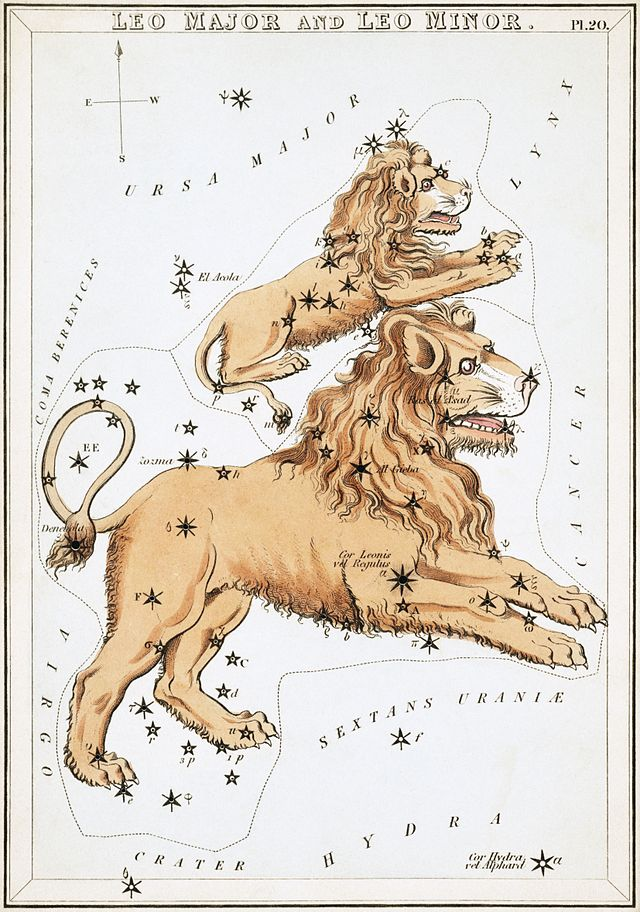
There is another lion-related constellation in our night sky, which is the Leo constellation. It belongs in the Zodiac family of constellations as it lies in the ecliptic.
We should not confuse Leo and Leo Minor with each other. Even though they are somewhat similar in names, they are very different. One great difference between the two is their size. Leo the Lion is a large constellation, the 12th largest in our sky. The Lesser Lion is much smaller compared to it. Out of the 88 modern constellations, it ranks 64th in terms of size. It occupies an area of 232 square degrees. Overall, that is just about 0.56% of our night sky!
What’s In A Name?
We already know that the nickname for Leo Minor is “the Lesser Lion.” Some other names for it are “the Smaller Lion,” oftentimes “the Little Lion,” and sometimes “the Lion Cub.” But before it became an official constellation, the area where it lies in the night sky used to be an undefined space. Ptolemy called it amorphōtoi as it was not part of any constellation outline.
Polish astronomer Johannes Hevelius described this new constellation in 1687. He wanted to give it a name that would relate to bigger constellations nearby, Leo and Ursa Major. After deciding whether to name it Leo Junior or Leo Minor, he chose the latter. This remained the name of the Lesser Lion as we know it today.
Other constellation names associated with Leo Minor are Al Thibā’ wa-Aulāduhā (Gazelle with her Young) and Leaena (the Lioness). The name Leaena was given by English astronomer Richard A. Proctor in 1870. His reason behind it is that he aimed to make the constellation’s name shorter for the celestial chart. However, this name did not catch on.

Quick Check: Johannes Hevelius
Johannes Hevelius was a German-Polish astronomer. People in Poland more commonly know him as Jan Heweliusz. He listed ten constellations in addition to the ones previously recognized. He had many contributions in the field of Science, particularly in Astronomy. And as an important name in the field, he became known to many as the “founder of lunar topography.”
Out of the ten constellations that he added, seven remained as IAU-recognized constellations. Leo Minor is one of them. He created this small constellation from 18 stars in this previously undefined area.
The ten constellations created by Hevelius are:
Canes Venatici (the Hunting Dogs)
Lacerta (the Lizard)
Leo Minor (the Lesser Lion)
Lynx (the Lynx)
Scutum (the Shield)
Sextans (the Sextant)
Vulpecula (the Fox)
While seven of Johannes Hevelius’s constellations are among the modern ones, three did not make it. These now-obsolete constellations are:
Cerberus
Cerberus had the form of a three-headed snake. Its stars are now part of the Hercules constellation.
Mons Maenalus
Mons Maenalus depicted a mountain below the Boötes constellation.
Triangulum Minus
Triangulum Minus means “the Smaller Triangle” in Latin. It was located close to the constellation of Triangulum.
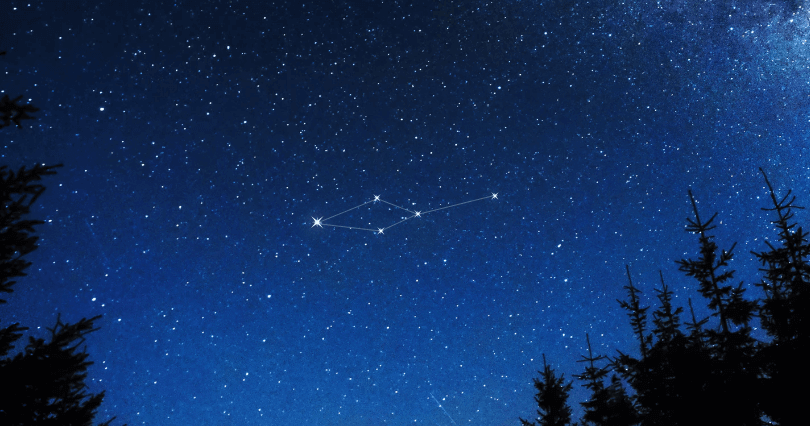
What Does Leo Minor Look Like?
Leo Minor is inside the boundaries of a 16-side polygon. This official boundary was set by Eugène Delporte. Inside it, we can see the diamond-like form of the Little Lion. This outline is formed by four stars with a fifth one outside. These stars are Praecipua, Beta Leonis Minoris, 30 Leonis Minoris, 21 Leonis Minoris, and 10 Leonis Minoris. We can relate its shape to a kite to easily remember it, with the line connecting to the fifth star as the string!
Some sources do not connect all five stars but rather just the three brighter ones. They form half of the diamond and can be seen with the unaided eye under a dark sky.
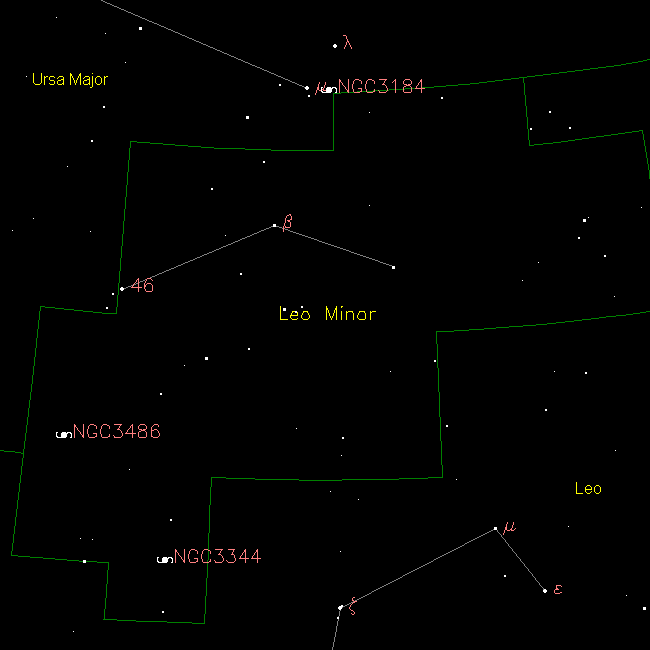
Another pattern interpreting the Lesser Lion is just a line connecting two of its stars and that is it!
Whatever pattern we may come across, it is better to know that they all mean one thing, the Lesser Lion!
Where To See the Leo Minor Constellation
Leo Minor lies north of the celestial equator. It is in the second quadrant (NQ2) of the northern sky. The borders of this small constellation lie at the right ascension of 10 hours and 35° north declination. From here on Earth, it can be seen between latitudes +90° and -45°. That means it can be seen by every observer from the northern hemisphere. It can also be seen in some places below the equator.
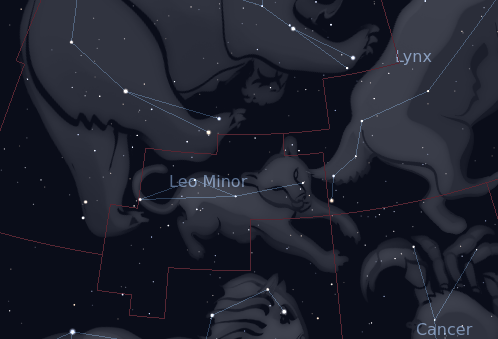
Leo Minor and Its Neighbors
Four bigger constellations surround Leo Minor. These are Ursa Major (the Great Bear) to the north, Leo (the Lion) to the South, Lynx (the Lynx) to the northwest, and Cancer (the Crab) to the southwest. We can use them as guides to see the Lesser Lion!
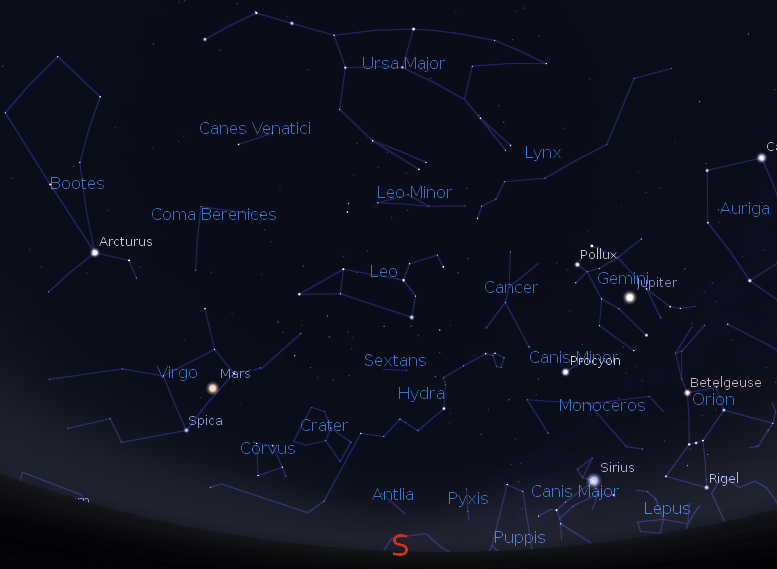
Other Ways to Spot the Lesser Lion
We have already learned that the faint constellation of Leo Minor is located between the brighter and bigger constellations of Leo and Ursa Major. They are some of the easiest forms to spot in the night sky because of their famous asterisms. And by spotting them, we can also find our way to Leo Minor.
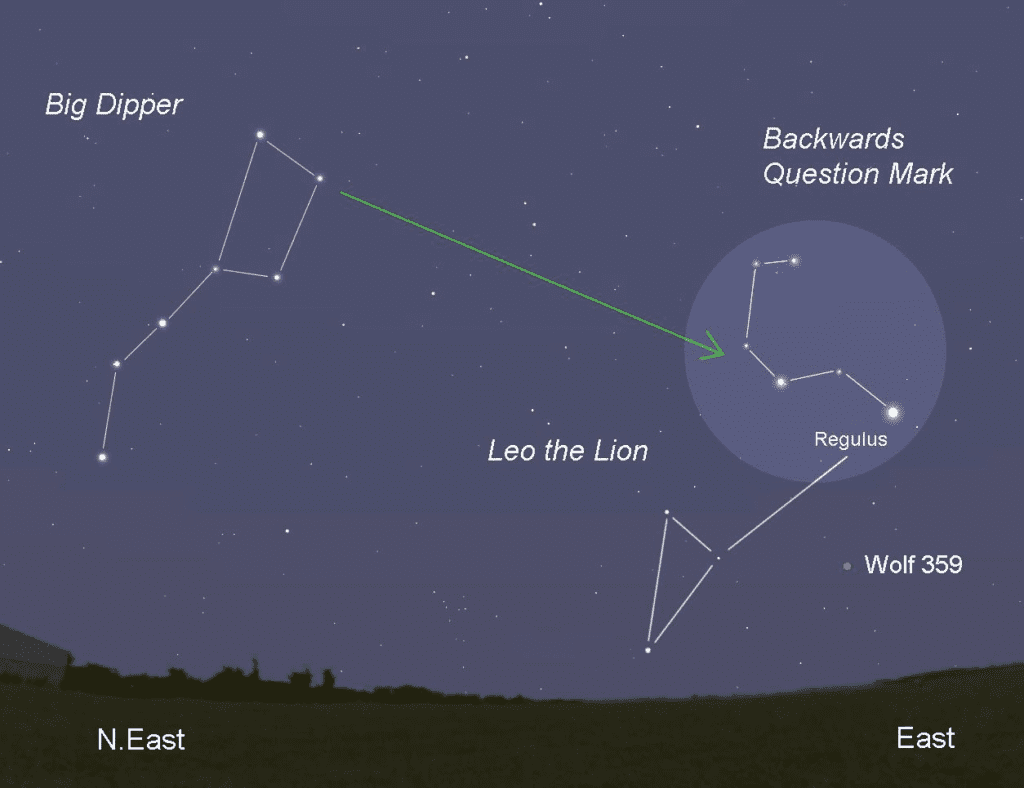
First, we need to find the Big Dipper in the Great Bear’s constellation. It is made up of seven stars that form the hind part and tail of Ursa Major. Its brightest star, Dubhe, is in this asterism. After spotting it, we can also find the Sickle in Leo. This asterism has the pattern of a backwards question mark. Though the area between them is quite obscured, that is where the Little Lion hides.
When To See the Leo Minor Constellation
Leo Minor is one of the seasonal constellations of the northern sky. We can see it in the night sky during springtime, that is, from March to May. The best time for us to see it is at 9 pm in the month of April. Other spring constellations that we can see in the northern hemisphere are Leo Minor’s neighbors Ursa Major, Leo, Lynx, and Cancer. Other prominent ones are Boötes, Hydra, and Virgo.
Leo Minor and Its Stars
Leo Minor has three main stars. It has 37 more that have apparent magnitudes brighter than 6.5. Two stars in this constellation are formally named. These are Praecipua, its brightest star, and Illyrian. Moreover, some of its stars are discovered to host planets.
The stars of the Lesser Lion are unique in a way that none of them was given the alpha designation. Out of the 88 modern constellations, it is the only one with no alpha star. It was because of some error made when English astronomer Francis Baily revised Johannes Hevelius’ catalogue.
It was common to assign the Greek letter Alpha to the brightest star in a constellation but he did not do so. Francis Baily only designated one Greek letter to Leo Minor and that is Beta Leonis Minoris. Other than that, there were also some confusions regarding the naming of its brightest star. The proper name that was given to it was previously used for another star in the constellation.
The aforementioned confusions were already settled so let us now know about Leo Minor’s stars.
Praecipua (46 Leonis Minoris)
Praecipua is the formal name given to the brightest star in Leo Minor. It is also known as 46 Leonis Minoris (46LMi) in the Flamsteed designation. It is a red clump giant with the spectral classification of K0+III-IV. Its apparent magnitude is 3.83, making it the only star in this constellation brighter than magnitude 4.
Praecipua has about 1.5 times the mass of the Sun and is more luminous than it by about 32 times. It lies about 95 light-years away from the solar system.
There were some confusions regarding the name of this star before. In Johann Elert Bode’s catalogue, it was designated “o LMi.” The “o” here means the English letter and not the Greek letter, Omicron. Another one is that the name Praecipua used to refer to 37 Leonis Minoris, a different star in the constellation. It is also interesting to note that even though it is the brightest star in Leo Minor, it was not given the Alpha designation.
The name Praecipua is Latin in origin. It means “the Chief (Star of Leo Minor).” This is the traditional name of this star which was standardized in 2017.
Beta Leonis Minoris (β Leonis Minoris)
Beta Leonis Minoris is the second brightest star in the constellation of the Lesser Lion. The Flamsteed designation for this star is 31 Leonis Minoris. It is a binary that is seen as a single G-type star. We can see in the naked eye as it has an overall apparent magnitude of 4.2.
The primary component of Beta Leonis Minoris is either a yellow giant or subgiant. It has the stellar classification G8III-IV. The radius of this star is about 7.8 times that of the Sun’s. It is also more massive and more luminous than the star of our solar system. The secondary component of β Leonis Minoris is moving away from the main sequence. It has a stellar classification of F8IV and has nearly twice the mass of our Sun. The two components of Beta Leonis Minoris have an orbital period of about 39 years.
Interestingly, Beta Leonis Minoris is the only star in the small constellation of Leo Minor that has a Greek letter, or Bayer designation. This system lies about 146 light-years away from our Sun.
21 Leonis Minoris
21 Leonis Minoris is a fast rotating star in Leo Minor. It is the third brightest star in this constellation after Beta Leonis Minoris. This white star in the main sequence has the stellar classification of A7V. Its apparent magnitude ranges from 4.47 to 4.52 as it is identified to be a Delta Scuti variable.
The star 21 Leonis Minoris has a radius 1.81 times that of the Sun’s and a surface temperature of about 7,800K. It is approximately 92 light-years distant from our planet.
37 Leonis Minoris
37 Leonis Minoris is a yellow star in the northern constellation of Leo Minor. It shines as a faint spot in the sky, having an apparent magnitude of 4.68. Its stellar classification is G2.5IIa, indicating that it is a bright giant.
This star has a mass that is about 3.72 times that of the Sun’s. It is about 200 million years old and is estimated to be 580 light-years away from us.
38 Leonis Minoris
38 Leonis Minoris is a spectroscopic binary. The overall apparent magnitude of this system is 5.84. The primary is a G-type subgiant that is more luminous than the Sun by about 11 times. 38 Leonis Minoris is about 170 light-years distant from Earth.
20 Leonis Minoris
20 Leonis Minoris is a binary star with an apparent magnitude of about 5.4. Its primary component has the stellar class of G3 Va. It is more massive than the Sun. The secondary star is a red dwarf. The star system of 20 Leonis Minoris is 49 light-years away from the solar system.
10 Leonis Minoris
10 Leonis Minoris is a variable star with stellar classification G8.5 III. It is also known as SU Leonis Minoris, its variable star designation. It has an apparent magnitude of about 4.54 and is more luminous than the Sun by 50 times or more. 10 Leonis Minoris is about 180 light-years distant.
11 Leonis Minoris
11 Leonis Minoris is a binary star system with an apparent magnitude of about 5.54. The primary component has the stellar class of G8V. It is a variable star whose luminosity varies by 0.033 magnitudes. The secondary star in this system is a red dwarf. The orbital period of the two components is 201 years. 11 Leonis Minoris is 36.5 light-years away from us.
R Leonis Minoris
R Leonis Minoris is another variable star in the Leo Minor constellation. It is a Mira variable whose spectral class is between M6.5e to M9.0e. It has a distance of more than 1,000 light-years from our planet.
RY Leonis Minoris (G 117-B15A)
RY Leonis Minoris is a pulsating white dwarf. This star is very interesting as it is said to be the most stable clock there is!
It has a period of 215.2 seconds which increases by one second only after 14 years million years. RY Leonis Minoris has an apparent magnitude of 15.5. It is about 400 million years of age.
Planets in the Lesser Lion’s Constellation
Three stars in the constellation of Leo Minor have exoplanets. Let us get to know them.
Kelt-3 b
Kelt-3 b is an exoplanet in Leo Minor orbiting the F-type star Kelt-3. It is a gas giant that was discovered in 2013. This exoplanet orbits around its star in a period of 2.7 days. This planetary system is 689 light-years away from Earth.
HD 87883 b
HD 87883 b is another exoplanet in the constellation of the Lesser Lion. This gas giant has a mass of 1.54 Jupiters. It orbits around the K-type star HD 87883 in a period of 7.5 years. The planetary system is 60 light-years distant from us.
HD 82886 b
HD 82886 b is an extrasolar planet that orbits the K-type star Illyrian (HD 82886) in Leo Minor. This gas giant has a mass of 2.33 Jupiters and an orbital period of 1.9 years. It was discovered in 2011. Just like its star, this exoplanet was given a name which is Arber. It is located 416 light-years away from our planet.
Deep-sky Objects in Leo Minor Constellation
There are no Messier objects in the faint constellation of Leo Minor but it has a lot of other interesting deep-sky objects. The first one on the list is the rare Hanny’s Voorwerp. Other celestial objects are galaxies AGC 198691, NGC 3486, NGC 3003, NGC 3021, and the Seyfert galaxies 3C 223 and 3C 234.
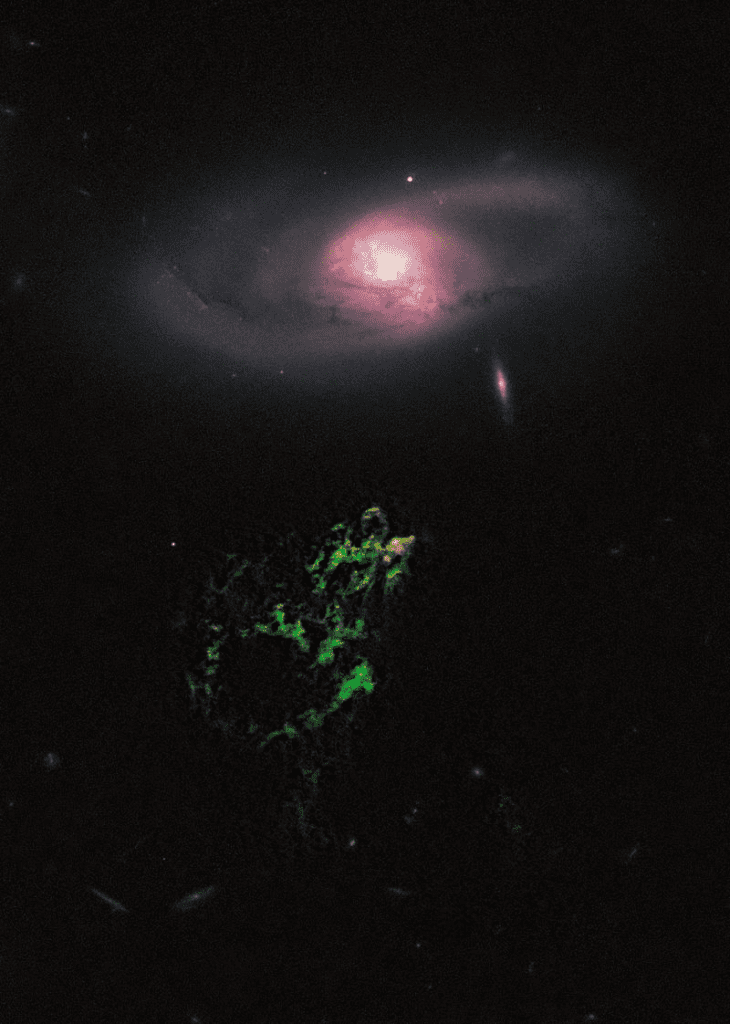
Hanny’s Voorwerp
Hanny’s Voorwerp is a unique deep-sky object. It is identified to be a quasar ionization echo about the size of the Milky Way. In the photo above, it is the mysterious object with a bright greenish light. The spiral galaxy above it is IC 2497. The two are estimated to be roughly 650 million light-years away from us. Star formation was observed in the voorwerp region facing the nearby galaxy.
There are several theories regarding Hanny’s Voorwerp. One is that there was a quasar in IC 2497 that was powered by a black hole. It suddenly turned off and what was left are the remnants of a small galaxy exhibiting the impact of radiation from this event.
Hanny’s Voorwerp means “Hanny’s Object,” from schoolteacher Hanny van Arkel who discovered it back in 2007. The Dutch teacher identified this mysterious object when she joined the Galaxy Zoo project online.
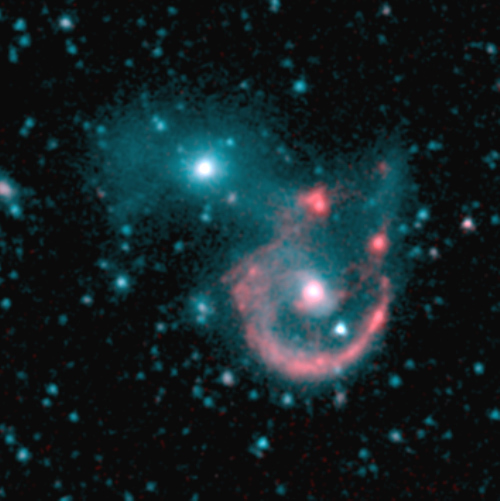
Arp 107
Arp 107 is an interacting galaxy pair in the process of merging. Young stars are formed on the tidal arm of the system. There are also older stars in this merger. The difference in the ages of these stars can be seen in the image above. The red area is made up of younger stars while the blue color indicates older stars.
The colliding galaxy pair Arp 107 is about 450 light-years away from Earth.
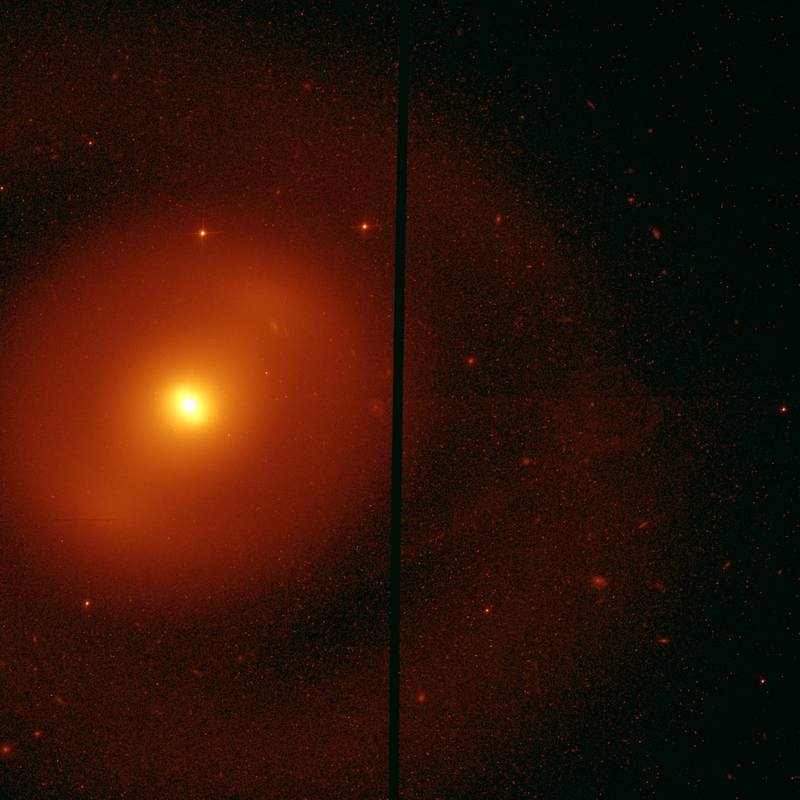
NGC 2859
NGC 2859 is another galaxy in Leo Minor. It is classified as a barred lenticular galaxy, having no visible spiral arms. This galaxy has a supermassive black hole in its center. It has a mass 105 million times that of the Sun’s. This galaxy lies at a distance of approximately 83 million light-years.
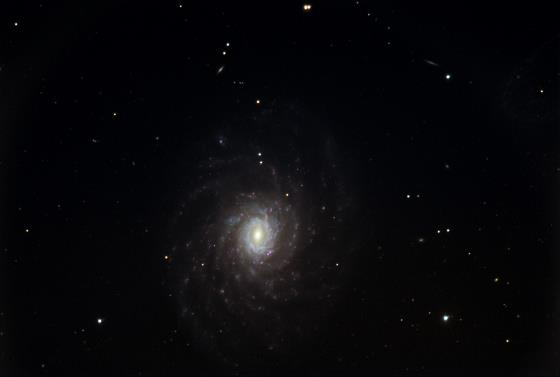
NGC 3486
NGC 3486 is a spiral galaxy in Leo Minor that appears almost face-on. It has an inner ring and branching arms. This galaxy has an active nucleus and is identified as a Seyfert galaxy. It is roughly 27.4 light-years away from us.
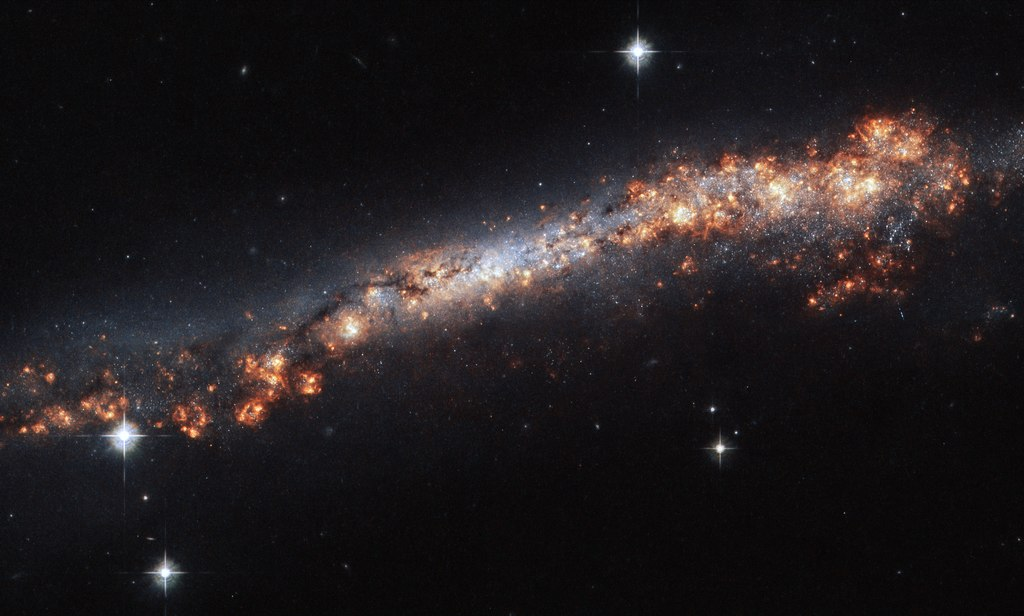
NGC 3432
NGC 3432 is a spiral galaxy that is interacting with the dwarf galaxy UGC 5983. Stars are formed from this interaction. It appears edge-on towards Earth. It is near the star 38 Leonis Minoris in the constellation of the Lesser Lion. This galaxy lies at a distance of 42 million light-years from the Sun.
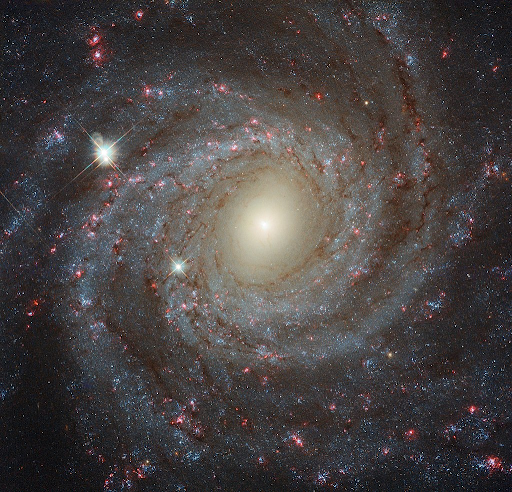
NGC 3344
NGC 3344 is a face-on galaxy in Leo Minor. It is a weakly barred spiral galaxy that is half the size of our own Milky Way. New stars are formed in its spiral arms. It is not part of the Local Group of galaxies but in a branch of the Virgo Supercluster. It lies about 20 million light-years distant.
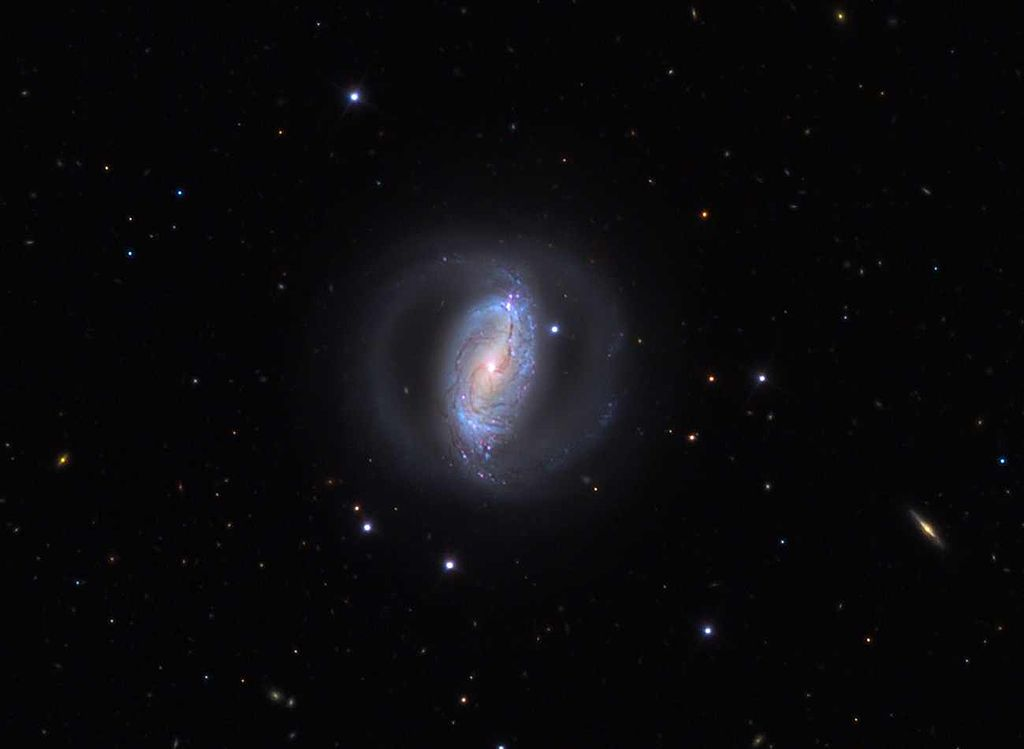
NGC 3504
NGC 3504 is another barred spiral galaxy in the Leo Minor constellation. It is also a starburst galaxy as it is a high-rate star-forming region. It has an apparent magnitude of 11.67.
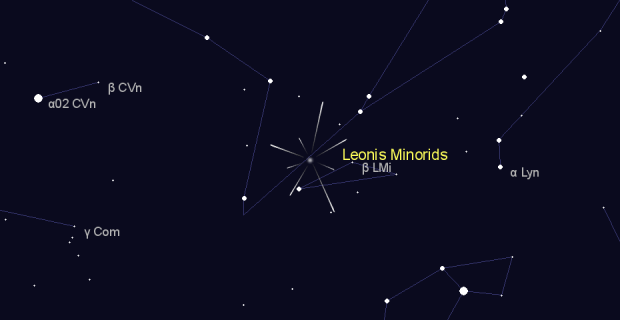
Meteor Showers Related to Leo Minor
Leonis Minorids – not to be confused with the Leonids – is the only meteor shower associated with Leo Minor. It has its apparent radiant or origin in this small constellation. This minor meteor shower happens yearly from around October 19 to 27. It peaks on the 23rd of the same month and can be best observed from the northern hemisphere.
The parent body of Leonis Minorids is the comet C/1739 K1. It has a zenith hourly rate of 2. That means we can see only two meteors per hour during the shower. The speed of the particles of Leonis Minorids is 62 km/s.
In a meteor shower, the population index tells us about the magnitude distribution of the meteors. And just like the apparent magnitude of stars, a smaller number means brighter meteors. Leonis Minorids has 3 as its population index. It was discovered in 1959 by Annette Posen and Dick McCloskey.